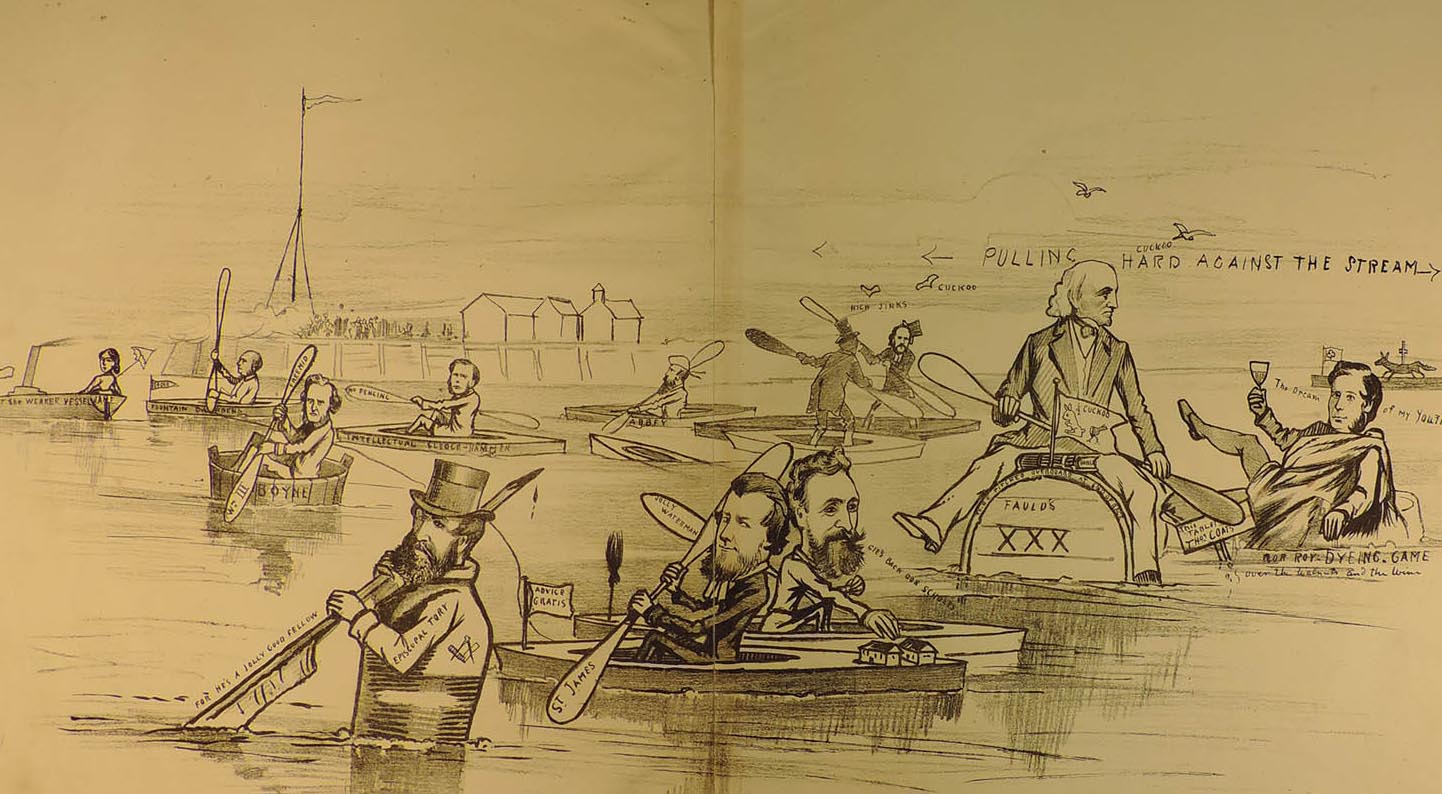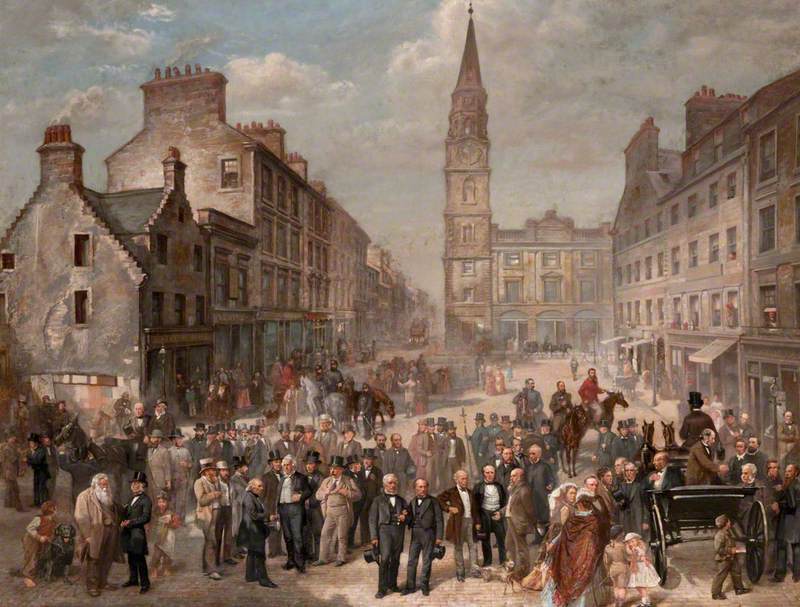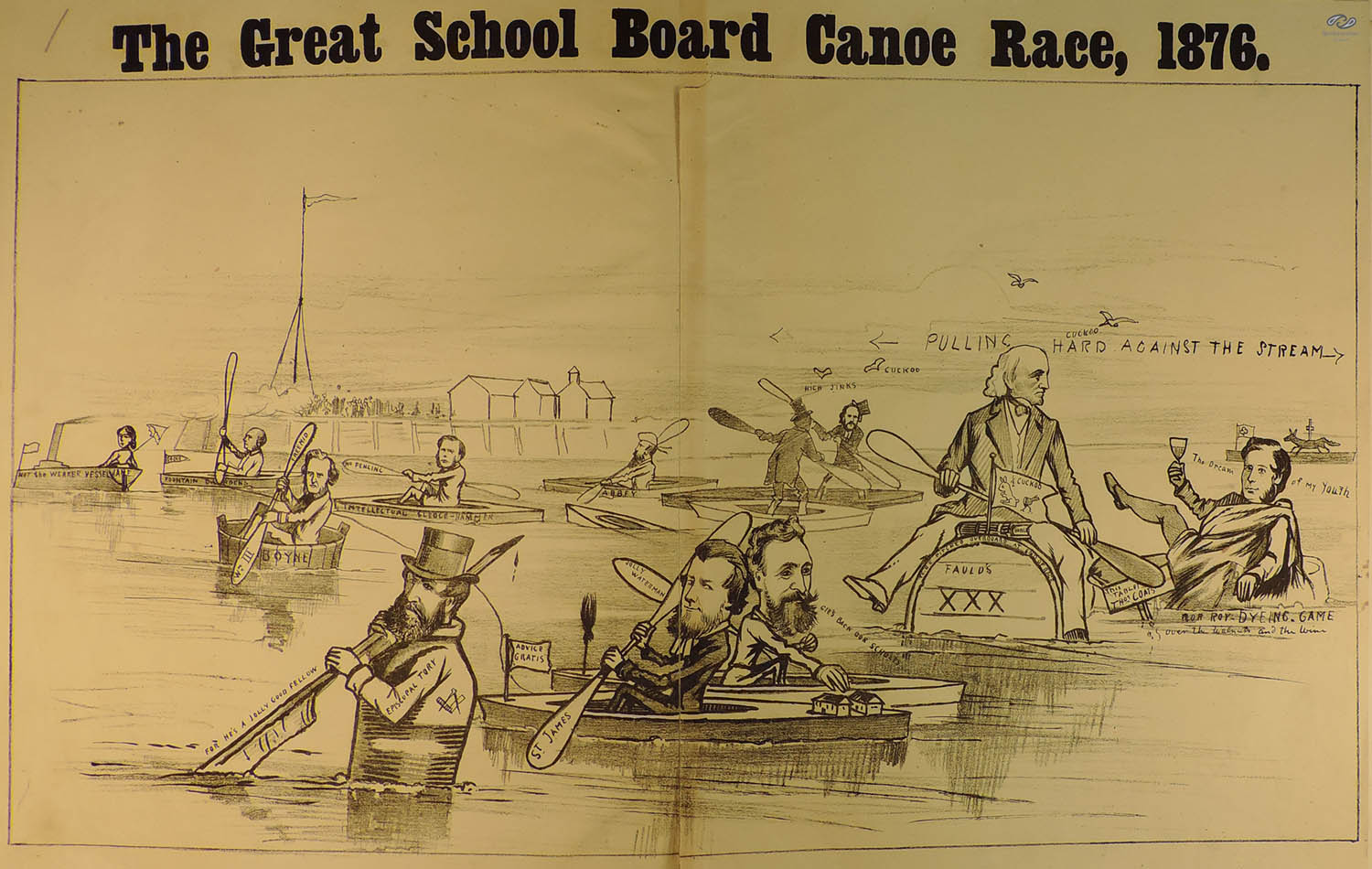
The Life and Times of Jane Arthur – Making National History part 2
The second article that looks back upon some of Renfrewshire’s pioneering figures that helped to mould our area into the prosperous and forward-thinking community that it is, artist and heritage consultant Lil Brookes guides us through the revolutionary and civic duty-led life of Jane Arthur as she becomes the first woman in Scotland to hold elected office
Jane & Women’s Suffrage Movement:
There is a well-known painting in the collection of Paisley Museum & Art Galleries which introduces and gives visual illustration perfectly to the times in which Jane Arthur was actively pursuing her advocacy of women’s suffrage. Known as Paisley Cross 1868 by James Elder Christie, Jane is pictured in the artwork.

Photo credit: Paisley Museum and Art Galleries, Renfrewshire Council Collections
As the title suggests the setting of the painting is Paisley Cross – the heart of the old town, a meeting place from the very beginning of Paisley. The men in the painting who look out at us are almost saying “look at us, we are Paisley in 1868, look at our liberal, prosperous and progressive town…!”
Notably, the second Great Reform Bill had been passed in 1867 and the Representation of the People (Scotland) Act came into force in 1868. This Act extended the right to vote to a wider range of men as the property ownership qualification was widened and meant more men gained the right to vote for the first time. The group of men shown in this painting celebrates Paisley as a liberal stronghold with all the values and beliefs upheld in the town burgh.
The group consists of members of the Coats and Clark family, as well as representatives of the Burgh council like the Provost and several Baillies, the Town Clerk, police and prison representatives, the MP and a variety of doctors, clergy, teachers and several lawyers. Most importantly, also captured in the artwork are small businessmen like painters, joiners and engineers, all men who’d recently been awarded the right to vote for the first time.
Despite the scale of the painting, there is only one woman portrayed in the painting – Jane Arthur. Why is Jane in this painting among all the men? Well, I believe she’s present as a well-known philanthropist in the town. But, as the message of this painting centres on the newly won right of more men to vote, it’s ironic that Jane cannot vote simply because she is female! Jane Arthur was prominent in the town for her charitable work, BUT she was also an advocate of the women’s suffrage movement and sought to gain the right to vote for women.
Following the extension of the right to vote for more men under the second reform act, the call to extend these rights to women became more vocal and the women’s suffrage movement became more organised throughout Scotland and the UK. In 1868, a change was proposed to the second reform act which was to change the wording of the act to read “persons” rather than the word “men” so that women would be included in the act under these terms.
This was raised and proposed in Parliament by the MP and philosopher John Stuart Mill, but his suggested amendment to the act was roundly defeated. From then on, the campaigners for women’s suffrage were undeterred and the call to extend women’s rights to vote continued and included a series of public meetings with female speakers on suffrage that were travelling throughout the country.
Furthermore, a local network of branches of the Women’s Suffrage Association were formed in Scotland and throughout the UK. As a liberal town, Paisley was no exception and like other locations throughout Scotland, public meetings with speakers and debates on women’s suffrage took place in the town throughout the period of 1869 to 1872.
However, one reform did become law and it had a positive effect on women’s suffrage and this was the Married Women’s Property Act of 1870. In short, this allowed married women to be the legal owners of the money they earned or of property they inherited. To explain at the time, the right to vote or to be a candidate in an election was tied to the rateable value of the property owned or rented by an individual.
Local council rates at the time covered the provision of things like poor relief, a local police force and public sanitary/cleansing services. Those owning or renting property of a set level of rateable value of property were liable to pay local council rates. The calls for women’s suffrage was also tied to this issue as following the Married Women’s Property Act of 1870, married women were now, by law, recognised as property owners, able to rent property and depending on the rateable value of property, also liable to pay council rates on property and as such, they should have the right to vote or stand for election.
In Paisley, a town council meeting held on the evening of 24th of February 1872 debated the issue of women suffrage. A report of the meeting in the Paisley and Renfrewshire Gazette at the time explained what one of the councillors, a Mr Watson, stated that night in relation to the 2nd Reform Act of 1867:
“…he gave notice that the Council petitioned both Houses of Parliament for an extension of the franchise to female ratepayers. He founded his claim entirely on the injustice that was at present being done to women by excluding them from the franchise.
Female ratepayers discharged the same obligations as were imposed on men, and he held that it was only right and fair that they ought to have the same political privileges. The Act of Parliament for the extension of the suffrage distinctly stated that the qualification of a voter was payment of rates, and if it was not broad enough to include women, the sooner it was altered the better…”
The period following the 2nd Reform Act was a highly volatile period and much debate on the right to universal male suffrage was discussed but equally, this was the period when the rights of women to vote were raised and ultimately led to a period of over a fifty long years of gradual awareness before women would secure the right to vote in 1918.
But what of Jane Arthur? What part did she play in all of this? Well, Jane was very much an advocate for women’s suffrage during this period. In the trade directory for Paisley (this is the Victorian equivalent of the Yellow Pages…!) In the year 1872, Jane is recorded as the President of the Women’s Suffrage Association (Paisley Branch). So, her inclusion in the aforementioned painting by James Elder Christie is recognition of her position in terms of her philanthropic and charitable work in the town, but I believe points to her advocacy of the right of women to vote or be selected as a candidate for elected office.
Being the President of the Women’s Suffrage Association in the year 1872, this also paves the way for Jane’s major life achievement of being elected as a member of the first Paisley School Board in 1873. In doing so, Jane was one of several women in Scotland who were elected on to the first public school boards in the country following the Education (Scotland) Act 1872.
“Not The Weaker Vessel” – Jane & the Paisley School Board:
It’s fair to say that by 1872, Jane was known in Paisley for her advocacy of women’s rights. Further to this, a new chapter in Jane’s life beckoned following the passing of the Education (Scotland) Act in 1872.
This Parliamentary act made it mandatory for all children aged 5 to 12 to receive elementary education in Scotland. To achieve this, it was necessary to transfer existing provision of elementary education delivered via charity schools and independent private institutions to become the responsibility of the local authority that was funded by the public’s local council rates.
At the time, this was an ambitious programme and a whole new network of school buildings and issues related to their maintenance and furnishing had to be attended to. To oversee this programme in each burgh and parish area throughout Scotland, the responsibility was given to elected school boards. Each school board would oversee the spending of public funds raised via the local council rate system and their members would be elected by eligible householders in a burgh/ parish. Householders who fit this criteria could not only vote for members of the school board, but could stand for office as a member of the school board.
The members of the school board would serve for a term of three years. Most importantly, the householders who met this criteria were both male and female. Fresh from the 2nd Reform Act of 1867 opening the right to vote to more men, this must have been recognised by Jane as a golden opportunity as this was the first time that women could vote for or stand in a local election to become an office bearer of a public board.
A hustings meeting took place at a local temperance hotel in Paisley on the 8th of April 1873, where Jane was nominated as a candidate for election to the first Paisley School Board. She was nominated by James Dobie, a dentist and was seconded by William Robertson, a draper. Her candidature statement, presented to the electorate by her campaign organiser James Clark, included her wish to make sure that girls received equal opportunity in education and the need for a woman to be on the school board in order to realise this desire.
It has to be said here that the election to the first Paisley school board caused great excitement in the town as this was an occasion for more candidates from a wide variety of economic and social backgrounds to be considered and in total, there were nineteen candidates chosen to run for election. Not only was Jane adopted as a candidate, but there were two men also put up as candidates who were described by the local newspaper as “tradesmen” who were “favourable to a working class representation on the school board”.
It was decided that the number of seats up for election to represent all of the wards in the burgh of Paisley would number nine in total. Subsequently, each eligible householder male and female would have 9 votes to cast. They could choose to give one candidate all nine of their votes or spread their votes among several or all of the candidates.
The day of the election was Wednesday 23 April 1873. The returning officer was Provost Murray. There were 6700 eligible householders who could vote in the election. There were two polling places in each of the four council wards in the town and one polling place for the householders in the Abbey parish. The voting papers were taken to be counted at the School of Art in Gilmour Street. By 10 o’clock that evening, the returning officer Provost Murray announced the nine successful candidates and the number of votes cast for each as follows:
Mrs Jane Arthur of Barshaw 6293 votes
Rev. Dr. Fraser, Middle Church 4902 votes
Mr Robert Henderson, Solicitor 3816 votes
Rev. James Dodds, Abbey 3725 votes
Mr Thomas Coats of Ferguslie House 3542 votes
Rev. G. C. Hutton, Canal Street UP Church 2962 votes
Rev. J McLachlan, RC Priest 2610 votes
Mr P Comyn MacGregor of Brediland 2478 votes
Rev. James Brown, St James UP Church 2286 votes
Result! Jane was first in the poll and her total number of votes was significantly higher than her rivals. To put this into perspective, her brother in law Thomas Coats, a prominent industrialist, local employer and benefactor of the town, came fourth in the poll behind Jane. Elsewhere, a high proportion of the successful candidates represented various religious denominations. It is interesting to think what may have happened and why Jane had such a runaway success in the poll. It may be fanciful, but I like to think it may have been that eligible voters cast all nine of their votes for Jane and gave no consideration to the other candidates, particularly as it was known that of the total number of eligible voters in the town, one fifth were women!
So, Jane Arthur was voted on to the first Paisley School Board and along with the other board members that served under the chairmanship of Thomas Coats, work could start in earnest with a programme of building works to construct and maintain a network of public elementary schools for the children of the burgh of Paisley. Boys and girls! Jane had succeeded in becoming the first woman to stand in and win an election to become an office bearer in a public school board in Scotland. Throughout the course of the next few months, several women followed and won places on public school boards. It had been proven that women could stand for and win an election and were more than able to hold office on public boards. Jane not only proved this once, but went on to stand and win a place on the Paisley School Board in future elections for the Board in 1876 and 1879.
During the period of the run up to the election of members to the second Paisley School Board in 1876, there were a series of satirical cartoons published in Paisley. There is a collection of these held at the Heritage Centre in Paisley and one of these is the inspiration for the title of this series.

The Great School Board Canoe Race 1876
“Not the weaker vessel…”
The cartoon which I refer to is titled “The Great School Board Race, 1876” and depicts a river with several boats and vessels of various shapes and sizes floating down stream. Each vessel or boat contains one of the candidates for the school board election in 1876, but way out in front is a vessel with a lady holding a parasol looking over her shoulder. Her little vessel is a steam powered boat called the “Jane” and at the prow of the boat is a further title which reads “Not the Weaker Vessel”. Jane Arthur and her achievement of running for and being elected to not one but three school boards from 1873 to 1879 is, for me, an indication of the talents and skills of Jane in local politics as well as in her advocacy for equality of education for girls.
- Jane at the time of the Paisley School Board Election from The Bailie magazine 1873
- Jane Arthur portrait from her obituary 1907
The Later Years…
Jane’s life was most certainly a full one and you might wonder what happened to her as many biographies of Jane finish at the mention of her success in being elected to the Paisley School Board, but it is only right to bring some closure to the events of her later life.
In 1885, her much loved husband James died at Carlung House in West Kilbride. She was now a widow and under the terms of her husband’s will, Barshaw House and Carlung House remained under her ownership for her life. Matthew Glen Arthur, the couple’s eldest son, became the chairman of the family firm and would inherit Carlung House on his Mother’s death, while his brother Thomas Glen Arthur would inherit Barshaw House under the same terms.
Jane retired from public life and lived at Carlung House, taking an active interest in the Paisley Convalescent Home that was situated nearby. Retirement to live in the country would have been a fitting end to Jane’s story. but some events occurred which made her later life take an unfortunate turn. In November 190,2 when Jane was aged 75 and had set out to visit her grandson in Paisley, Carlung House caught fire and burnt down. Some of the household furniture and valuables were salvaged, but this left Jane’s main residence in her widowhood destroyed.
The effects of this loss on her cannot be known for certain but this was a much loved house and a particular favourite place for her late husband. Following this event, Jan, whose health was failing, went to live in a seaside residence called Blackburn Villa in Ayr and near to where he eldest son Matthew lived in Troon at Fullarton House. Further misfortune hit Jane and her family as early as 1907 when her son Thomas Glen Arthur tragically died.
Jane passed away only a few months later on 25 May 1907 at Blackburn Villa in Ayr, representing the end of a full life and well deserving of the tributes paid to her in her home town of Paisley.
From her obituary published in the Paisley and Renfrewshire Gazette, one of the mourners was quoted as saying that:
“…Paisley had lost one of its best citizens in the death of Mrs Arthur, and he was sure her name would long be remembered…”
Jane Arthur was an advocate of women’s suffrage, equality of educational opportunities for girls and women as well as the benefactor of numerous philanthropic and charitable causes related to temperance, social welfare, health and housing. Now, over a hundred years after her death, her name is beginning to once again be spoken following many years of being forgotten and I for one, think that’s a cause for celebration.
More information about Lil’s work and community activities can be found on her Facebook page. She has also launched a new website which you can view here. Read part one of The Life and Times of Jane Arthur.


